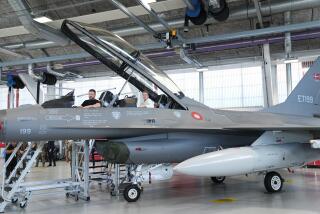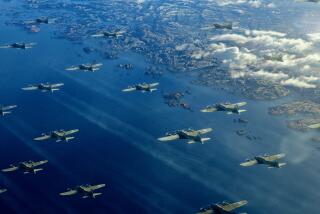Civilian Hitches Wild, Fast Ride in F-16
ABOVE THE SOUTH CHINA SEA — Fists and teeth clench, toes curl and capillaries explode as the body fights to stop blood being sucked from the brain during a gravity-be-damned ride in an F-16--one of the world’s most agile fighter planes.
Faster than the speed of sound, the craft screams into a turn and within seconds a 10-pound human head weighs almost 90 pounds and a neck feels like a toothpick.
As the plane accelerates to 600 knots (about 690 mph), skin is stretched beyond a Hollywood plastic surgeon’s wildest dreams and it feels as though a herd of elephants is doing the tango on your abdomen.
The experience is called “pulling Gs” and it hurts like the devil.
“Scream and laugh as much as you want,” U.S. Air Force Maj. Pete “Birdman” Bird says during the flight in Singaporean air space over the South China Sea--a rare occasion when a civilian has been allowed on board. “It’s good for pulling Gs.”
The flight is taking place during a routine training visit to Singapore by the U.S. Air Force’s 35th Fighter Wing, based in Misawa, Japan.
The $20 million F-16 outclasses other fighter planes in its fast, hard turns in air-to-air combat and air-to-surface attacks. It also provides a wild, trying experience for anyone on board.
Bird, who’s 39 and has been flying for 20 years, works the plane into a “G-warm up” of about 6.5 Gs to get the adrenaline pumping.
G stands for gravity and measures its pull. One G is what people feel most of the time on Earth, though a scary roller coaster can have them pulling 2 or 3 Gs. The unprepared body can stand up to 5 Gs, but special breathing exercises and muscle-flexing are needed to sustain anything higher. As G-forces rise, the body’s weight increases. At five Gs, a 200-pound man weighs 1,000 pounds.
On the F-16, the G-forces go up to nine.
“It’s easier for women to pull Gs,” said Capt. Michele Meyer, 30, from San Diego and the wing’s only female fighter pilot. “Our center of gravity is lower and the distance between the brain and the heart is shorter so it [the heart] doesn’t have to work as hard.”
Bird, who is from Seattle, is ready for more Gs. He breaks the sound barrier and zooms into a turn at 8.5 Gs--which feels as though your innards are being squashed, because they are.
One pilot described breaking the sound barrier for the first time as “anticlimactic” because of the silence. The sound is too far behind to hear the boom.
“See that guy down there in the fishing boat?” Bird asks, tilting the plane so you feel weightless for an instant and pointing to the sea. “He heard it.”
At 17,500 feet it’s difficult to appreciate how fast you’re moving. At 5,000 feet it’s frighteningly apparent as Singapore’s skyscrapers whoosh past.
The jet flies by Changi Airport and a new naval base being built large enough to berth U.S. Navy aircraft carriers.
Singapore has a multibillion-dollar defense budget that includes an undisclosed number of F-16s and other warplanes. It holds joint military exercises frequently with U.S. forces, and American soldiers, sailors and pilots are often seen darting in and out of Singapore nightspots.
Bird swoops down to 6,000 feet to demonstrate the F-16’s acrobatic capabilities and then lets a civilian reporter fly the plane.
“Do whatever you want--just don’t go below 5,000 feet,” he says.
After a nosedive and a low-G turn with a spectacular view of the Indonesian islands of Bintan and Batam, Bird takes back the controls to fly upside down--an exercise that can result in weightlessness, or negative Gs--but only briefly because “it hurts your head,” he says.
Bird says a glove or article of clothing would float in a state of weightlessness while pulling negative Gs. But safety rules prohibit removing the fireproof gloves or any other part of the elaborate “fight” suit.
To ensure survival, a “G-suit” containing compressed air is strapped on over a lightweight garment. Under increased G levels, the G-suit’s air expands from the ankles up. The flight helmet is fitted with an oxygen mask for breathing and a microphone for communicating with the pilot.
The G-suit helps push the blood back up into the body, but it’s common for pilots to suffer ruptured capillaries on their arms and legs--a condition known as “G-measles.”
“Most people get nauseous,” said Dr. Demetrio Aguila, the flight surgeon who conducted a preflight physical at a Singapore air base.
To be deemed fit to fly, a person needs to be relatively healthy and able to clear their ears. Plastic vomit bags are tucked into the G-suit within easy reach.
If the G-suit and the exercises fail and blood is sucked into the ankles, starving the brain of oxygen, a pilot will go into “G-lock,” lose his sight, his consciousness and most likely his life.
If anything happens to him, Bird says, pull the yellow “eject” handle in the tiny cockpit and be prepared for the ride of your life as you’re launched into space “like a rocket.”
A harness attaches F-16 pilots to their seats, which contain a parachute and an inflatable raft.
Fortunately, the yellow handle is not necessary over the South China Sea.
After landing “smooth as a baby’s bottom,” Bird announces: “Congratulations--you just defied death.”
More to Read
Sign up for Essential California
The most important California stories and recommendations in your inbox every morning.
You may occasionally receive promotional content from the Los Angeles Times.










